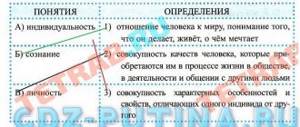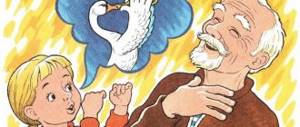Summary of a social studies lesson in 6th grade on the topic: “Human personality”
Summary of a social studies lesson in 6th grade on the topic: “Man is a personality”
Goals and objectives:
introduce students to the characteristic features inherent in a person, the meaning of his existence; give an idea of the essence of human duality; describe a strong personality.
Planned results:
students must learn to identify the personal and individual characteristics of a person; compare social objects, finding out their common features and differences; master the principles of working with a textbook, the text of which contains diagrams, additional text and questions, and also be able to conduct a discussion, heuristic conversation, work with documents, analyze problems, solve problematic problems, work in a group.
Formed UUD:
Subject:
apply the conceptual apparatus (man, personality, strong personality, individuality) to reveal the essence of human nature; be able to analyze, compare, study and systematize various historical and modern sources of information; find the necessary social information; understand the importance of society for the formation of personality and work activity for the individual and society;
Metasubject
– 1) communicative: accurately and competently express your thoughts, defend your point of view during the discussion, ask questions necessary to organize your own activities;
2) regulatory: independently discover and formulate an educational problem; search and highlight the necessary information;
3) cognitive: carry out an extensive search for information; analyze, compare, classify and summarize facts and phenomena; give definitions to concepts;
Personal:
focus on active and creative participation in public life, interest not only in personal success, but also in the development of various aspects of social life; analysis of one’s own actions from the point of view of human nature, responsibility for one’s decisions; development of creative abilities through active forms of activity.
Lesson type:
discovery of new knowledge.
Equipment:
textbook, multimedia presentation
During the classes:
1) organizational moment
2) motivational-target stage
— Listen to the parable and answer the questions.
One day Hing Shi was sitting on the shore of a small but very picturesque lake with one of his students. The air was filled with subtle aromas, the wind died down, and the mirror-like surface of the reservoir reflected everything around it with incredible clarity. The perfection of nature, its balance and purity gave rise to thoughts of harmony. Hing Shi turned to his student with a question: “Yang Li, tell me, when do you think there will be complete harmony in human relations?” The young and inquisitive Yang Lee thought and after a while, looking at the identity of the reflection of the landscape in the lake, he said: “It seems to me that harmony in relations between people will come only when all people come to a common opinion, think alike, become like a reflection of each other. Then there will be no disagreements or disputes.” And he sadly added: “But is this possible?” Hing Shi replied: “This is impossible, and it is not necessary. Indeed, in this case, there would not be harmony, but a complete depersonalization of a person, the loss of his inner “I”, individuality. People would become not so much a reflection as a shadow of each other.” After a short silence, the sage added: “Harmony in human relations will become possible only when each person strives not for unity of opinion or imitation of others, but for respect for the right of another person to express his individuality.”
Questions for the class
— How did you understand the meaning of this parable?
- What is she talking about?
Lesson topic: “Man is a personality.”
- What do you think we will talk about today?
- Open the textbook on p. 8 and answer the questions in the “Remember” section.
So, the lesson plan:
- What is personality?
- Individuality – good or bad.
- A strong personality - what is it?
3) Introduction to new material
Each of us has probably asked the question more than once: “Who am I? What am I? Why did I come into this world? What can I do for him? In the 21st century, people have solved more than one mystery that previously seemed unsolvable. But for a person himself there is no more interesting mystery than penetration into his own nature, knowledge of himself. For centuries people have asked themselves the question: “Who are we and what are we like?” - and could not answer it.
The ancient poet Sophocles wrote:
There are many miracles in the world,
The man is the most wonderful of them all.
4) Work on the topic of the lesson
1. What is personality (1 hour)
When we use the concept “man,” we mean a representative of the human race, a unique creation of nature, possessing a number of common properties.
- Remember what the dual essence of man is?
(biological and social)
Man is the greatest mystery of the universe, which all great philosophers have been struggling to uncover for several millennia. Man is a highly developed living being belonging to the biological species Homo Sapiens (Homo sapiens). Like any organism, a person has sense organs, circulatory, muscular, skeletal, nervous and other systems. However, its natural qualities manifest themselves in more complex interactions.
The ancient Greeks, who created the cult of the human body, admired the special biological organization of man.
In the 19th century, Darwin proved that man represents the pinnacle of the evolutionary development of nature and differs from other animals in exceptional biological perfection. This position was expressed in very famous words: “Man is the crown of nature.”
As a higher mental being, man has reason. However, the human mind reveals itself both in creative creation, social mutual assistance, and in the violent conquest of nature, the malicious destruction of millions of people. Consequently, if man, thanks to reason, has separated himself from the animal world, he must constantly confirm the status of a rational being, called upon to preserve and transform life on Earth.
Exercise:
Thus, we see that man is a biosocial being.
Now your task is to create a diagram in your notebook:
Option 1 – writes biological traits and characteristics of a person, Option 2 – social traits and characteristics of a person
Human:
- biological being - part of living nature; an organism that lives according to biological laws
- a social being endowed with reason who: is capable of reflection; solve the most complex problems; can fully develop only in a society of its own kind.
We are convinced that without a society of his own kind, a person cannot develop successfully. Therefore, scientists distinguish two stages in human development:
- children's society - family and school (play, work, learning)
- adult society – family, work (study, work)
we see that in the course of his development a person becomes a personality.
- What is personality? What image do you have when you hear the word “personality”?
Personality is a set of human qualities that appear:
In the process of living in society,
As a result of activities,
In the process of communicating with other people
Only personality has consciousness!
Consciousness is a person’s attitude to the world and an understanding of what a person does, how he lives, what he dreams of.
Consciousness gives a person the opportunity to engage in various activities, communicate with other people, evaluate others and himself.
(diagram on slide)
Task:
open p.
9, read and write down the answers to the questions in your notebook: 1) From what time does a person become a person?
When he begins to understand himself; with the separation of one’s self from other people; with the emergence of individuality; every person is an individual, but the degree of respect for this individual varies
2) Are all the people around us individuals?
Whether a person is respected or not can be determined by how a person works (studies, plays); relates to the surrounding world; evaluates himself
3) Write down the main personality characteristics.
Ability to work; purposefulness, will, diligence, perseverance, the ability to overcome difficulties, and be critical of your successes.
Homework
1) Read paragraph 1, p. 8-9, answer the questions after paragraph 1.2 (test yourself), task 1 (in class and at home)
2) Answer the questions in the “Let’s Discuss Together” section
3) Read the statement of the ancient Roman philosopher Seneca and explain its meaning: “The soul cannot be one color, and the mind cannot be another. If the soul is healthy, if it is calm, sedate and self-controlled, then the mind will be clear..."
4) Based on the text of the textbook and your own experience, evaluate what qualities for successful work are well developed in you? What else needs work? What personality traits are especially attractive to you, and which ones would you like to develop in yourself?
(orally)
Lesson 2 (1 hour) - continuation
1)
checking homework (orally)
2) working on the topic of the lesson (continued)
2. Individuality – good or bad
Assignment: turn to the art gallery section on p. 10-11 textbook. Before you are two portraits of girls. Make up verbal descriptions of the girls. Use the words for this: thoughtful, dreamy, active, sad, cheerful, smiling.
— Is it possible to determine character traits and behavioral traits by their appearance?
People have common features: a certain body structure, the ability to think, speak and much more, but at the same time, each of us has our own distinctive characteristics.
- one at a time at the board: guess what common features make up individuality? What associations and thoughts come to your mind when you hear the word individuality? (result – diagram on the slide)
Individuality:
- habits (snapping fingers, chewing pens, etc.)
- appearance (face, hair, physique)
- culture
- race
- temperament (sanguine, choleric, melancholic, phlegmatic)
- creativity, etc.
Every person is unique, and that's wonderful. Now let’s look at what forms this uniqueness, and what factors exist that shape a person’s individuality.
A person’s individuality is formed under the influence of three groups of factors:
- heredity and physiological characteristics (appearance, eye color, nose shape, body structure)
- factors stemming from a person’s environment (as a result of interaction with family, friends, school)
- traits and characteristics of a person’s character (as a result of personal self-development)
A person receives some individual personality traits by inheritance, while others are acquired by communicating with parents and friends.
- task for discussion - imagine that we came to a discussion club where there is a problematic question - is individuality good or bad? The first option is arguments in defense of individuality, the second option is arguments against individuality. Whoever wins in this discussion - the most active ones will receive A's, others - nothing. For help - from 12-13 textbook.
3) a strong personality – what is it like?
The concept of “strong personality” is usually used to characterize a strong-willed person who is able to express his own opinion and achieve a lot by setting a goal.
- Let’s turn to the section “Once upon a time there lived a man” on page 15. Read aloud and answer the questions:
— Can Beethoven be called a strong personality? Why?
- this was an example of a world-famous personality. Now read the story about the boy Misha on p. 15, second paragraph. Can Misha be considered a strong personality?
Fear is inherent in every person. But a strong person differs from a weak one in that he can overcome his fear. (tell them about your fears and ask them what they are afraid of)
Our last task for today is to create a portrait of a strong personality. Additional material will help us. Distribute material about Nick Vujicic and, based on the textbook, create a portrait of a strong personality and check it together.
The result is a strong personality:
- thinks first of all about the interests of the business. Which he deals with, giving it paramount importance, and only then - about his personal life, family, recreation, etc.
- strives for heights that no one has conquered before
- has self-confidence and self-confidence, initiative
- has high moral qualities and takes responsibility
- has a creative streak
- realizes his capabilities and strives to expand them
- does not respect authorities, strives to do everything his own way
If you have time, read the statements and determine what unites them.
“It’s easy to mix with the crowd, but it’s hard to be yourself in it!” (group “Epidemic”, Time of Choice)
“Don't imitate others. Find yourself and remain yourself, because “envy is ignorance” and “imitation is suicide”” (Dale Carnegie)
“The smarter a person is, the more originality he sees in everyone with whom he communicates. For an ordinary person, all people look the same” (Blaise Pascal)
4) homework
1) Read paragraph 1, p. 12-15, answer the questions after paragraph 3.4 (test yourself), task 2-3 (in class and at home)
2) Look at the picture on p. 14 textbooks, orally answer questions about the picture
3) Assignments from the workbook in writing (on separate pieces of paper)
Additional material for the lesson.
Nick Vujicic - anything is possible
“Nick Vujicic was born in Australia in 1982 into the family of a nurse and a priest without arms or legs. Imagine, he couldn’t do anything on his own; his family and friends had to look after him 24 hours a day. Nick's childhood was very difficult both physically and psychologically, because he had almost no friends, and there was constant ridicule around him. However, the young man managed to get a higher education, now he does everything on his own and even... swims! And his typing speed on a computer is 43 words per minute. But this is just the tip of the iceberg. He was ahead of many physically able people, conducts seminars all over the world and helps people like him, disabled people and people who have problems, begin to appreciate life, fight and move forward. It would seem that a man without arms and without legs, but inspires ordinary people: to live without giving up, to live for loved ones. Each of us has something to learn from him.”






